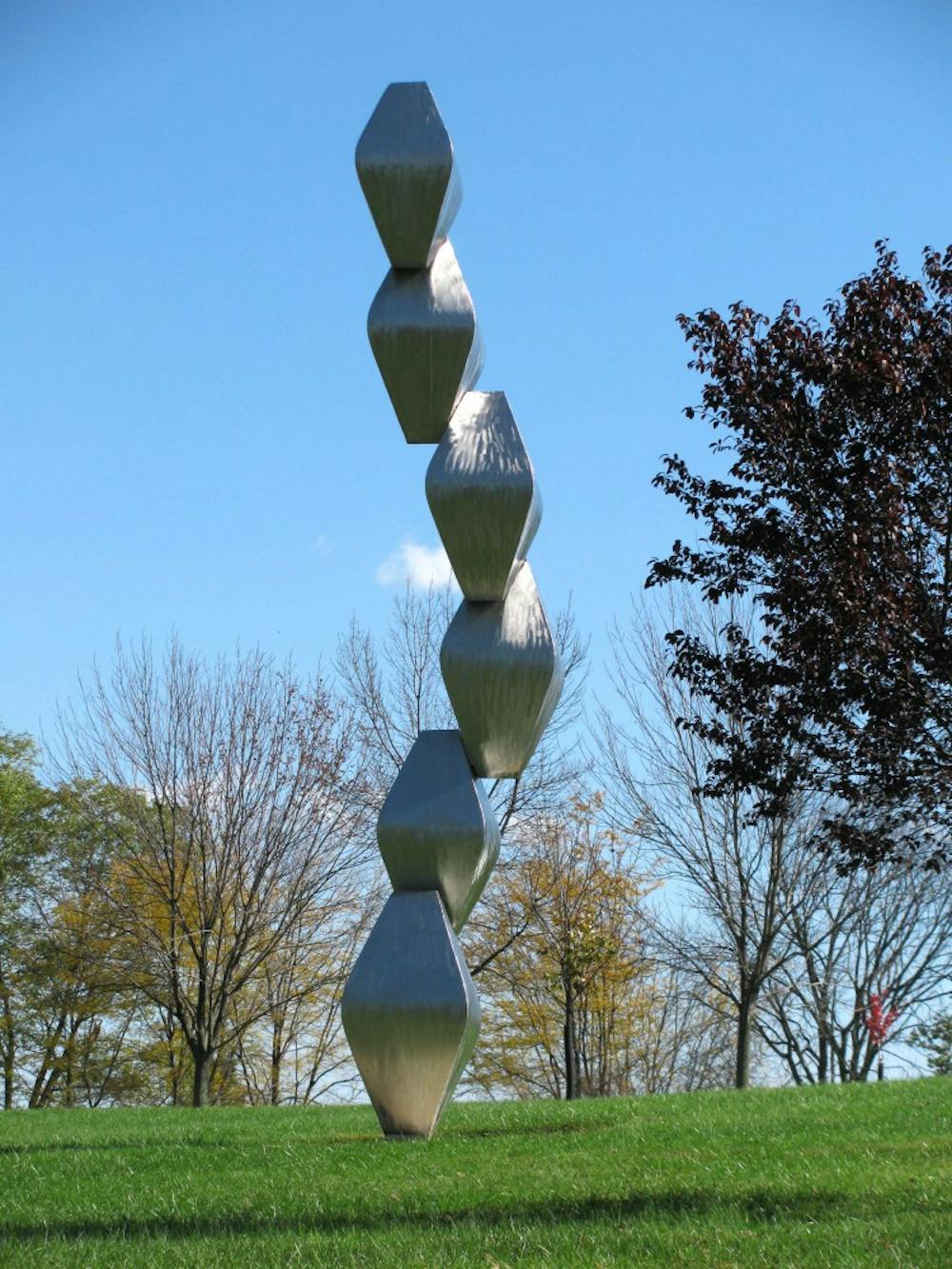Just a short 25-minute drive from Miami's campus, metal sculptures dozens of feet tall dot the landscape of the Pyramid Hill Sculpture Park. From the bright orange behemoth that is sculptor Alexander Liberman's abstract "Abracadabra" to the monumental bronze and steel of Michael Dunbar's "Euclid's Cross," a walk through this park makes it hard to believe you're just outside Hamilton, OH.
The 265-acre park was created by Harry T. Wilks (yes, the same Wilks who is the namesake of the Armstrong Student Center's theatre and Miami's Leadership Institute). A likeness of Wilks, immortalized by sculptor John Leon, lounges on the right side of the bench in the park, inviting visitors to take a seat next to him.
Wilks first bought the property to build his personal residence, but, after his home was completed in 1995 he received several offers to purchase home sites on the land.
By that time, though, Wilks had an attachment to the beauty of the property -- to its fields and forests and bodies of water. Instead of selling off parcels of the land, Wilks formed a nonprofit foundation and started to travel, visiting sculptors and purchasing art.
The sculpture park's grand opening in the spring of 1996 was highly anticipated, and, thanks to annual events like Holiday Lights on the Hill and the annual Hamilton Art Fair, interest in the site hasn't waned for the past decade. Pyramid Hill is still the largest nonprofit in Butler County and attracts more visitors than every other site in the county.
In 1791, the U.S. army constructed a fort where modern-day Hamilton stands now. At the time, this area of Ohio was Native American territory. The first residential development outside of Fort Hamilton was the German Village -- a nine-block cluster of historic buildings north of the city's business district and alongside the Great Miami River.
When the area was built up in 1796, it was home to the city's first court, school and newspaper. Now the district, which boasts 19th century architectural styles from Italiante to Gothic Revival, has received a major facelift, from the bricks lining 3rd Street to the six-acre Marcum Park which opens later this month.
German Village's 3rd Street was made for an afternoon stroll. Wander into Lane Library and peruse a book in its octagonal reading room, lined with dark wooden bookshelves and flooded with natural light from its floor-to-ceiling windows. Browse through handmade home items at Your Homely Sister -- but, like the sign on the shop's door warns, don't let the cat wander out the door.
Talk to any of the shopkeepers on the street and you're likely to get a similar response: Hamilton is changing, and they're proud of it. While the city is humming with excitement over its new additions, much of its charm still lies in its historic roots.
Hamilton's historic buildings have appeared in several films in the past several years, like 2015's multi-Oscar-nominated "Carol," meaning A-listers like Cate Blanchett and James Franco have recently walked the city's streets.
Just last week, a portion of Hamilton's S. 3rd Street was blocked off to film a scene for "The Old Man and the Gun," a crime drama set for a 2018 release produced by and starring Robert Redford. Recent Academy Award winner Casey Affleck, who is also starring in the film, was in Hamilton last week for filming.
The people at True West, a cafe and coffee shop with locations on Main Street and High Street, have also embraced a sunny outlook for the city's future.
A multi-colored mural of Alexander Hamilton -- the country's first Treasury Secretary, subject of a blockbuster Broadway musical and, of course, the namesake of the city -- can be seen from the Main Street parking lot. On the fence lining the shop's outdoor seating area is the message, "I believe in Hamilton."
Though the tables and couches of Oxford's Kofenya are often packed -- especially leading up to finals week -- the two floors of True West's Main Street location are packed with study space possibilities. Find a spot where you can take in the shop's brightly painted walls, eclectic paintings and patterned paper stars which dangle from the second story of the building.
With its old floorboards, creaky stairs and varied decor, it feels a little like your grandma's house -- if your grandma were an artist with a funky wardrobe and a coffee addiction.
In addition to its coffee and espresso options, True West also serves a variety of sandwiches and salads. I picked the "Granny," served on rye bread and packed with layers of thinly sliced turkey, green apple slices and honey mustard. The food itself is nothing remarkable, but the simple meals, served on mismatched plates, are just right for a lazy afternoon outside Oxford.

